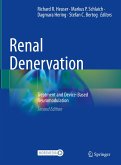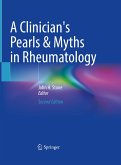Walter Gottlieb Land
Damage-Associated Molecular Patterns in Human Diseases (eBook, PDF)
Volume 1: Injury-Induced Innate Immune Responses
112,95 €
112,95 €
inkl. MwSt.
Sofort per Download lieferbar

56 °P sammeln
112,95 €
Als Download kaufen

112,95 €
inkl. MwSt.
Sofort per Download lieferbar

56 °P sammeln
Jetzt verschenken
Alle Infos zum eBook verschenken
112,95 €
inkl. MwSt.
Sofort per Download lieferbar
Alle Infos zum eBook verschenken

56 °P sammeln
Walter Gottlieb Land
Damage-Associated Molecular Patterns in Human Diseases (eBook, PDF)
Volume 1: Injury-Induced Innate Immune Responses
- Format: PDF
- Merkliste
- Auf die Merkliste
- Bewerten Bewerten
- Teilen
- Produkt teilen
- Produkterinnerung
- Produkterinnerung

Bitte loggen Sie sich zunächst in Ihr Kundenkonto ein oder registrieren Sie sich bei
bücher.de, um das eBook-Abo tolino select nutzen zu können.
Hier können Sie sich einloggen
Hier können Sie sich einloggen
Sie sind bereits eingeloggt. Klicken Sie auf 2. tolino select Abo, um fortzufahren.

Bitte loggen Sie sich zunächst in Ihr Kundenkonto ein oder registrieren Sie sich bei bücher.de, um das eBook-Abo tolino select nutzen zu können.
Describes current knowledge of the role of DAMPs in inducing immune responses
Explores the significance of DAMPs in a wide range of human diseases
Illustrates innovative data from immunity and inflammation research and their impact on medical practice
- Geräte: PC
- ohne Kopierschutz
- eBook Hilfe
- Größe: 22.41MB
Andere Kunden interessierten sich auch für
![Damage-Associated Molecular Patterns in Human Diseases (eBook, PDF) Damage-Associated Molecular Patterns in Human Diseases (eBook, PDF)]() Walter Gottlieb LandDamage-Associated Molecular Patterns in Human Diseases (eBook, PDF)112,95 €
Walter Gottlieb LandDamage-Associated Molecular Patterns in Human Diseases (eBook, PDF)112,95 €![Damage-Associated Molecular Patterns in Human Diseases (eBook, PDF) Damage-Associated Molecular Patterns in Human Diseases (eBook, PDF)]() Walter Gottlieb LandDamage-Associated Molecular Patterns in Human Diseases (eBook, PDF)88,95 €
Walter Gottlieb LandDamage-Associated Molecular Patterns in Human Diseases (eBook, PDF)88,95 €![Diabetes and Cardiovascular Disease (eBook, PDF) Diabetes and Cardiovascular Disease (eBook, PDF)]() Diabetes and Cardiovascular Disease (eBook, PDF)112,95 €
Diabetes and Cardiovascular Disease (eBook, PDF)112,95 €![Renal Denervation (eBook, PDF) Renal Denervation (eBook, PDF)]() Renal Denervation (eBook, PDF)72,95 €
Renal Denervation (eBook, PDF)72,95 €![Immunology of Neuromuscular Disease (eBook, PDF) Immunology of Neuromuscular Disease (eBook, PDF)]() Immunology of Neuromuscular Disease (eBook, PDF)40,95 €
Immunology of Neuromuscular Disease (eBook, PDF)40,95 €![Adipose Tissue (eBook, PDF) Adipose Tissue (eBook, PDF)]() Adipose Tissue (eBook, PDF)112,95 €
Adipose Tissue (eBook, PDF)112,95 €![A Clinician's Pearls & Myths in Rheumatology (eBook, PDF) A Clinician's Pearls & Myths in Rheumatology (eBook, PDF)]() A Clinician's Pearls & Myths in Rheumatology (eBook, PDF)68,95 €
A Clinician's Pearls & Myths in Rheumatology (eBook, PDF)68,95 €-
-
-
Describes current knowledge of the role of DAMPs in inducing immune responses
Explores the significance of DAMPs in a wide range of human diseases
Illustrates innovative data from immunity and inflammation research and their impact on medical practice
Explores the significance of DAMPs in a wide range of human diseases
Illustrates innovative data from immunity and inflammation research and their impact on medical practice
Dieser Download kann aus rechtlichen Gründen nur mit Rechnungsadresse in A, B, BG, CY, CZ, D, DK, EW, E, FIN, F, GR, HR, H, IRL, I, LT, L, LR, M, NL, PL, P, R, S, SLO, SK ausgeliefert werden.
Produktdetails
- Produktdetails
- Verlag: Springer International Publishing
- Seitenzahl: 870
- Erscheinungstermin: 9. Oktober 2018
- Englisch
- ISBN-13: 9783319786551
- Artikelnr.: 54282699
- Verlag: Springer International Publishing
- Seitenzahl: 870
- Erscheinungstermin: 9. Oktober 2018
- Englisch
- ISBN-13: 9783319786551
- Artikelnr.: 54282699
- Herstellerkennzeichnung Die Herstellerinformationen sind derzeit nicht verfügbar.
Walter G. Land is Professor Emeritus of the LMU University in Munich, Germany. After earning his MD, he spent 4 years specializing in Experimental Surgery, Immunology, and Organ Transplantation at the Institute for Surgical Research, LMU University, Munich. In 1979 he performed the first pancreas transplant in Germany at Klinikum Großhadern, where he subsequently spent almost 30 years as Head of the Transplantation Center. He also held a position as C3 Professor for Surgery and Transplantation Surgery in Munich for almost 20 years, until 2004. After his retirement as a surgeon, he is still scientifically active in the field of innate immunity, while also holding positions as Visiting Professor at Baskent University, Ankara (Turkey) and as Professeur Conventionné at the University of Strasbourg (France). Professor Land has been a co-founder of many European and German Societies, including the European Society for Organ Transplantation (ESOT), European College of Organ Transplantation, the German Transplantation Society, the German Academy of Transplantation Medicine. He is also a member of the Transplantation Society and the German National Academy of Sciences Leopoldina and an honorary member of the American Society of Transplant Surgeons and the European Academy of Tumor Immunology. Professor Land has chaired the European Society for Organ Transplantation and the German Academy for Transplantation Medicine. He is the author or editor of many articles and books and was awarded the Erich Lexer Prize by the German Surgical Society in 1991, the Order of Merit of the Federal Republic of Germany in 1996, the Bavarian State Medal for Social Merit in 1997, the Millennium Medal of the Transplantation Society in 2000, and the Maharshi Sushruta Prize for Transplantation Biology in India in 2005.
Part I. The Three Major Paradigms in Modern Immunology.- Prologue: The Term "Immunity" over the Course of Time.- The Three Major Paradigms in Immunology.- Epilogue: What Major Paradigm in Immunology Comes Next?.- Part II. The Innate Immune System: an Organ of Perception Determined to Maintain Homeostasis.- Prologue: The Guardians of Homeostasis.- Innate Immune Recognition Molecules.- Epilogue: The Innate Immune System: a Global Player in Health and Disease.- Part III. The Whole Family of Mammalian Innate Immune Cells.- Prologue: The Whole Body as an Immune System?.- Mobile Innate Immune Cells.- Sessile Innate Immune Cells.- Epilogue: The Whole Body as an Immune Defence System.- Part IV. The World of DAMPs. Prologue: About DAMPs, PAMPs and MAMPs.- Endogenous DAMPs, Category I: Constitutively Expressed Native Molecules (Cat. I DAMPs).- Endogenous DAMPs, Category II: Constitutively Expressed, Injury-Modified Molecules (Cat. II DAMPs).- Endogenous DAMPs, Category III: Inducible DAMPs (Cat. III DAMPs).- Exogenous DAMPs, Category IV (Cat. IV DAMPs).- Epilogue: The Well-Dosed Work of DAMPs in their Commission to Restore and Maintain Homeostasis.- Part V. Cellular Stress Responses and Regulated Cell Death.- Prologue: Innate Immune Tools to Defend against Stressful Injury: Success and Failure.- Cell-Autonomous (Cell-Intrinsic) Stress Responses.- Regulated Cell Death.- Epilogue: The Horror of an Injury-Induced Avalanche of DAMPs.- Part VI. Innate Immune Effector Responses.- Prologue: The Various Facets of Innate Immune Effector Responses.- Cellular Inflammatory Responses.- Humoral Innate Immune Effector Responses.- Regulation of Innate Inflammatory Responses.- Epilogue to Part VI.- Part VII. Function of Innate Lymphoid Cells and Unconventional T Cells with Partial Innate Function.- Prologue: The "Ready-to-Go" Lymphocytes of the Immune System.- Activating and Function of Innate Lymphoid Cells.- Activating and Function of Unconventional T Cells.- Epilogue: Killer Lymphocytes as Tools for Future Immunotherapeutic Approaches.- Part VIII. DAMPs Promoting Adaptive Immunity and Tissue Repair.- Prologue: The "Long Arm" of DAMPs in Shaping Adaptive Immune Responses and Tissue Repairing Processes.- Antigen Uptake, Processing and Presentation by Dendritic Cells.- Antigen in the Presence of DAMPs Induces Immunostimulatory Dendritic Cells to Promote "Destructive" Acquired Immune Responses.- Antigen in the Absence of DAMPs Promotes Immunotolerance: the Role of Dendritic Cells and Regulatory T Cells.- An Impressive Example of Peripheral Tolerance against Nonself: Tolerance to Commensal Bacterial and Dietary Protein Antigens.- Immunometabolism of Dendritic Cells and T Cells.- Role of DAMPs in Tissue Regeneration and Repair.- Epilogue: DAMPs as Key Players in the Pathogenesis of Many Human Diseases.
Part I. The Three Major Paradigms in Modern Immunology.- Prologue: The Term "Immunity" over the Course of Time.- The Three Major Paradigms in Immunology.- Epilogue: What Major Paradigm in Immunology Comes Next?.- Part II. The Innate Immune System: an Organ of Perception Determined to Maintain Homeostasis.- Prologue: The Guardians of Homeostasis.- Innate Immune Recognition Molecules.- Epilogue: The Innate Immune System: a Global Player in Health and Disease.- Part III. The Whole Family of Mammalian Innate Immune Cells.- Prologue: The Whole Body as an Immune System?.- Mobile Innate Immune Cells.- Sessile Innate Immune Cells.- Epilogue: The Whole Body as an Immune Defence System.- Part IV. The World of DAMPs. Prologue: About DAMPs, PAMPs and MAMPs.- Endogenous DAMPs, Category I: Constitutively Expressed Native Molecules (Cat. I DAMPs).- Endogenous DAMPs, Category II: Constitutively Expressed, Injury-Modified Molecules (Cat. II DAMPs).- Endogenous DAMPs, Category III: Inducible DAMPs (Cat. III DAMPs).- Exogenous DAMPs, Category IV (Cat. IV DAMPs).- Epilogue: The Well-Dosed Work of DAMPs in their Commission to Restore and Maintain Homeostasis.- Part V. Cellular Stress Responses and Regulated Cell Death.- Prologue: Innate Immune Tools to Defend against Stressful Injury: Success and Failure.- Cell-Autonomous (Cell-Intrinsic) Stress Responses.- Regulated Cell Death.- Epilogue: The Horror of an Injury-Induced Avalanche of DAMPs.- Part VI. Innate Immune Effector Responses.- Prologue: The Various Facets of Innate Immune Effector Responses.- Cellular Inflammatory Responses.- Humoral Innate Immune Effector Responses.- Regulation of Innate Inflammatory Responses.- Epilogue to Part VI.- Part VII. Function of Innate Lymphoid Cells and Unconventional T Cells with Partial Innate Function.- Prologue: The "Ready-to-Go" Lymphocytes of the Immune System.- Activating and Function of Innate Lymphoid Cells.- Activating and Function of Unconventional T Cells.- Epilogue: Killer Lymphocytes as Tools for Future Immunotherapeutic Approaches.- Part VIII. DAMPs Promoting Adaptive Immunity and Tissue Repair.- Prologue: The "Long Arm" of DAMPs in Shaping Adaptive Immune Responses and Tissue Repairing Processes.- Antigen Uptake, Processing and Presentation by Dendritic Cells.- Antigen in the Presence of DAMPs Induces Immunostimulatory Dendritic Cells to Promote "Destructive" Acquired Immune Responses.- Antigen in the Absence of DAMPs Promotes Immunotolerance: the Role of Dendritic Cells and Regulatory T Cells.- An Impressive Example of Peripheral Tolerance against Nonself: Tolerance to Commensal Bacterial and Dietary Protein Antigens.- Immunometabolism of Dendritic Cells and T Cells.- Role of DAMPs in Tissue Regeneration and Repair.- Epilogue: DAMPs as Key Players in the Pathogenesis of Many Human Diseases.







